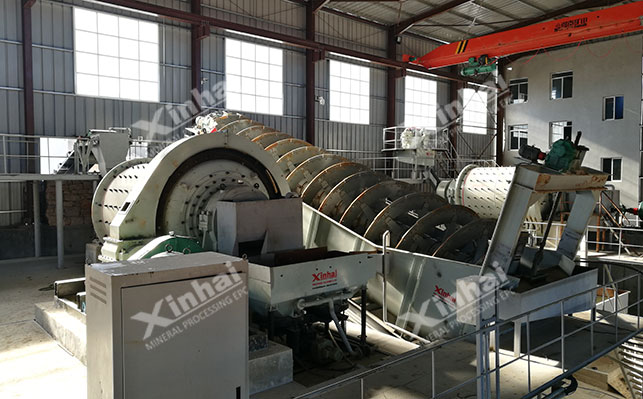
15311826613
Click to add WeChatGranite is a type of igneous rock. It is a crystalline rock mass formed by the gradual cooling and condensation of magma deep in the earth's crust. The main mineral components are quartz, feldspar and mica. It is mostly yellow, flesh red, pink, etc., and occasionally grayish white. After mineral processing and purification, it can be used in glass, ceramics and other fields. So what does the granite-type feldspar ore beneficiation process include? Let’s follow the editor to find out.
Generally, for this type of feldspar ore, the process flow of crushing-grinding-grading-flotation (removal of iron and mica)-flotation (separation of quartz and feldspar) is often used. Taking a certain granite mine as an example, the process flow will be introduced.

The crushing process of this feldspar ore mainly includes: crushing-screening point. The process flow adopts Three stages and one closed-circuit crushing. After the minerals are sent from the storage bin to the feeder, they are sent to the first stage of crushing by the feeder to achieve as much mineral dissociation as possible and reach a reasonable particle size. , are sent to the second stage crushing operation by the 1# belt conveyor. The crushed products are screened by vibrating screens. Qualified materials are sent to the third stage crushing, while unqualified materials are returned to the second stage crushing operation by the belt conveyor for re-crushing. When the third stage After the crushing is completed, it enters the storage bin to facilitate subsequent grinding operations.

The main purpose of the grinding process is to further grind the crushed mineral particles into finer particles. Achieve full dissociation between feldspar and other minerals to meet optional particle size requirements. Two-stage grinding closed-circuit process is commonly used in this stage. The crushed products are sent to the wet rod mill for grinding. The ground products use hydraulic classification equipment to control the crushed particle size content. In order to meet the particle size requirements of glass and ceramic raw materials, the monomers are finally dissociated and enter the sorting stage.

Flotation is the use of quartz, feldspar, and mica minerals in different environments The difference in potential uses surfactant to selectively adsorb on the surface of feldspar and mica minerals, making the surface of the minerals hydrophobic and adhering to the bubbles to float, thus achieving the separation of the two. This stage is mainly divided into two parts. One stage of the flotation operation is mainly for the purpose of iron and mica removal, while the other stage is for the effective separation of quartz and feldspar >.

Floatation of feldspar to remove iron and mica:After removing fine mud, the product is recycled through a process of one coarse and two fines Mica, obtain mica concentrate, and then use magnetic separation method to remove magnetic iron substances.
Floatation feldspar/quartz separation:The pretreated mineral particles are fluorine-free flotation, adding sulfuric acid or hydrofluoric acid as a regulator, and adding ammonium salts to capture The collector is used for slurry flotation. During the flotation process, the feldspar floats in the form of foam. The floating feldspar is collected to separate feldspar and quartz minerals. Then the slurry is mixed and amine salts and petroleum sulfonates are added. The anionic and cationic mixed collectors are used for reverse flotation to obtain quartz concentrate, and the tailings part is feldspar concentrate.
The above is an introduction to the mineral processing process of granite feldspar ore. In the actual mineral processing plant, the feldspar ore is selected according to different mineral types, different ore properties, and different impurity minerals. There are also differences in the mineral processing process. It is necessary to design a mineral processing process plan and a suitable Complete sets of mineral processing equipment can obtain reasonable quartz sand ore.